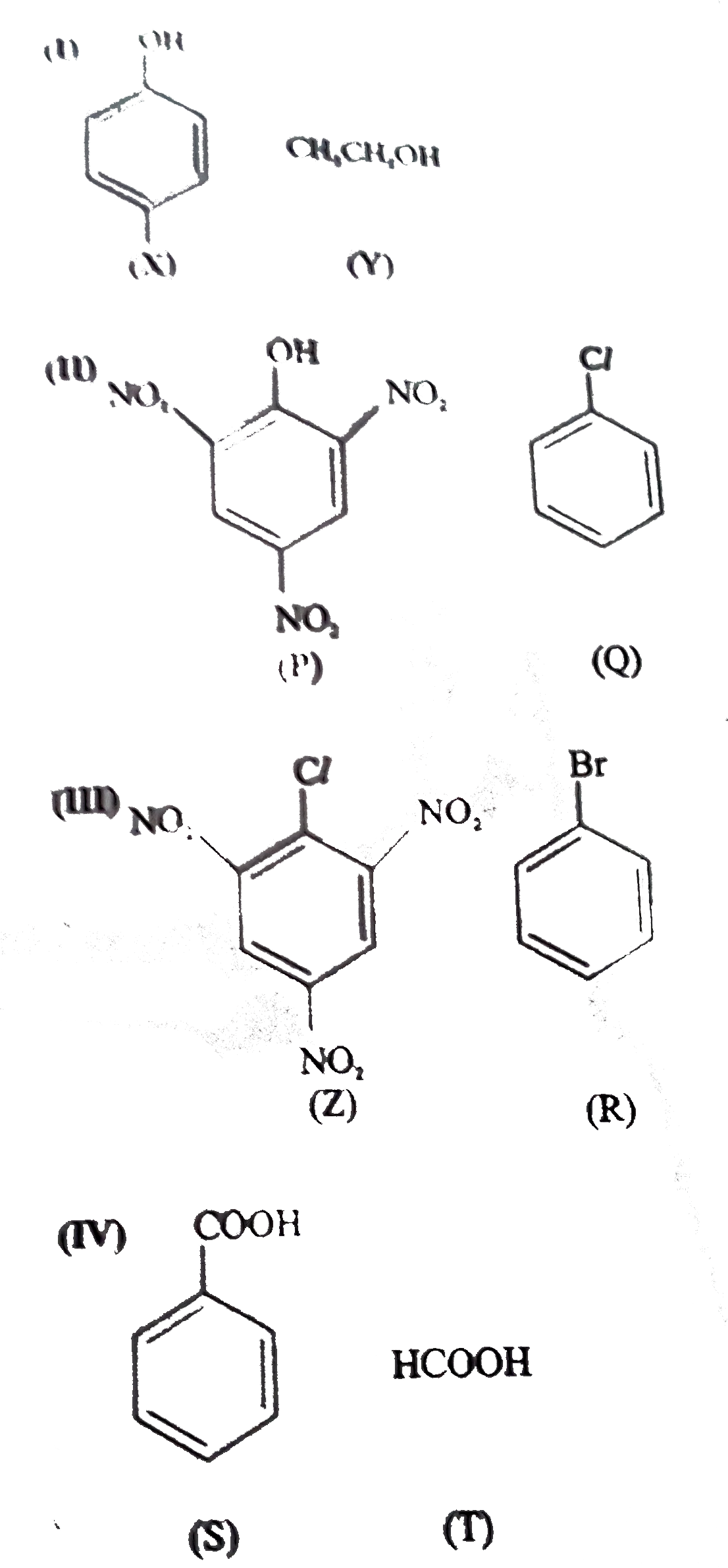The most reactive among the following towards sulphonation is
toluene
chlorobenzene
nitrobenzene
m - Xylene
The correct Answer is:d
To determine the most reactive compound towards sulfonation among the given options (A: Toluene, B: Chlorobenzene, C: Nitrobenzene, D: Meta Xylene), we need to analyze the electronic effects of substituents on the benzene ring and how they influence nucleophilicity.
1. Understanding Sulfonation:
- Sulfonation involves the electrophilic substitution of a sulfonyl group (SO3) onto an aromatic compound. The electrophile (SO3) will be attacked by a nucleophile, which in this case is the aromatic ring.
2. Identify the Compounds:
- A: Toluene (C6H5CH3)
- B: Chlorobenzene (C6H5Cl)
- C: Nitrobenzene (C6H5NO2)
- D: Meta Xylene (C6H4(CH3)2)
3. Analyze Each Compound:
- Toluene (A): The methyl group (CH3) is an electron-donating group (+I effect), which increases the electron density on the benzene ring, making it more nucleophilic and reactive towards electrophiles.
- Chlorobenzene (B): The chlorine atom has a +M effect (resonance donation) but also a -I effect (inductive withdrawal). The net effect is a decrease in electron density on the ring, making it less reactive than toluene.
- Nitrobenzene (C): The nitro group (NO2) is a strong electron-withdrawing group (-M effect), which significantly decreases the electron density on the ring, making it the least reactive towards sulfonation.
- Meta Xylene (D): This compound has two methyl groups. Methyl groups are +I donors, which increases the electron density on the ring. The presence of two methyl groups enhances the nucleophilicity even more compared to toluene.
4. Compare Reactivity:
- Toluene has increased nucleophilicity due to one methyl group.
- Chlorobenzene has decreased nucleophilicity due to the combined effects of chlorine.
- Nitrobenzene has the lowest nucleophilicity due to the strong electron-withdrawing effect of the nitro group.
- Meta Xylene, with two methyl groups, has the highest nucleophilicity due to the combined +I effects.
5. Conclusion:
- Among the given compounds, Meta Xylene (D) is the most reactive towards sulfonation due to the presence of two electron-donating methyl groups, which significantly increase the electron density on the aromatic ring.
Final Answer:
D: Meta Xylene is the most reactive towards sulfonation.
- Sulfonation involves the electrophilic substitution of a sulfonyl group (SO3) onto an aromatic compound. The electrophile (SO3) will be attacked by a nucleophile, which in this case is the aromatic ring.
- A: Toluene (C6H5CH3)
- B: Chlorobenzene (C6H5Cl)
- C: Nitrobenzene (C6H5NO2)
- D: Meta Xylene (C6H4(CH3)2)
- Toluene (A): The methyl group (CH3) is an electron-donating group (+I effect), which increases the electron density on the benzene ring, making it more nucleophilic and reactive towards electrophiles.
- Chlorobenzene (B): The chlorine atom has a +M effect (resonance donation) but also a -I effect (inductive withdrawal). The net effect is a decrease in electron density on the ring, making it less reactive than toluene.
- Nitrobenzene (C): The nitro group (NO2) is a strong electron-withdrawing group (-M effect), which significantly decreases the electron density on the ring, making it the least reactive towards sulfonation.
- Meta Xylene (D): This compound has two methyl groups. Methyl groups are +I donors, which increases the electron density on the ring. The presence of two methyl groups enhances the nucleophilicity even more compared to toluene.
- Toluene has increased nucleophilicity due to one methyl group.
- Chlorobenzene has decreased nucleophilicity due to the combined effects of chlorine.
- Nitrobenzene has the lowest nucleophilicity due to the strong electron-withdrawing effect of the nitro group.
- Meta Xylene, with two methyl groups, has the highest nucleophilicity due to the combined +I effects.
- Among the given compounds, Meta Xylene (D) is the most reactive towards sulfonation due to the presence of two electron-donating methyl groups, which significantly increase the electron density on the aromatic ring.
D: Meta Xylene is the most reactive towards sulfonation.
Topper's Solved these Questions
- HYDROCARBONSBOOK - DISHA PUBLICATIONCHAPTER - HYDROCARBONSEXERCISE - EXERCISE -2 CONCEPT APPLICATOR
29 Videos
- HYDROCARBONSBOOK - DISHA PUBLICATIONCHAPTER - HYDROCARBONSEXERCISE - EXERCISE -2 CONCEPT APPLICATOR
29 Videos
- HALOALKANES AND HALOARENES BOOK - DISHA PUBLICATIONCHAPTER - HALOALKANES AND HALOARENES EXERCISE - Exercise -2 : Concept Applicator
28 Videos
- HYDROGENBOOK - DISHA PUBLICATIONCHAPTER - HYDROGENEXERCISE - Exercise - 2 : Concept Applicator
30 Videos
Similar Questions
Knowledge Check
The most reactive metal among the following is:
AAlBNiCPbDCuThe most reactive among the following pairs towards NaOH is
 AIn I-XBIn II-QCIn III-ZDIn IV-T
AIn I-XBIn II-QCIn III-ZDIn IV-TThe most reactive element among the following is:
ANaBKCCaDMg
The most reactive nucleophile among the following is
View SolutionThe most reactive nucleophile among the following is
View SolutionThe most reactive nucleophile among the following is
View SolutionThe most reactive nucleophile among the following is
View SolutionThe most reactive nucleophile among the following is :
View Solution
